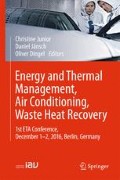Abstract
Caloric materials – in particular magneto-, electro- and elastocaloric materials – show a strong reversible thermal response close to a ferroic phase transition when they are exposed to their respective fields. By cyclic operation of these materials and their alternating thermal coupling to heat sink and source, efficient heat pumps can be realized where no harmful fluids are involved. In the last few years several different groups worldwide have worked on the improvement of the properties of caloric materials as well as on the development of caloric cooling systems with larger temperature span, cooling power and efficiency. Basically, all of these systems are based on a concept using a heat transfer fluid which is actively pumped through a bed of caloric material in order to transfer thermal energy from a heat source to a heat sink. Hereby, especially for magnetocalorics, several powerful systems were built, generating large temperature spans of more than 50 K while others provide large cooling capacities of several kW. However, up to now no caloric system has been built which provides large temperature span and cooling capacity while having a coefficient-of-performance (COP) better than standard compressor-based cooling systems.
In this work, a new concept and first experimental data of a caloric heat pump will be presented. In this concept, the heat transfer is realized by the combination of caloric material with thermal diodes which are based on latent heat transfer. Similar to thermosyphons, thermal energy is efficiently transported by condensation and evaporation processes leading to heat transfer rates which are several orders of magnitude larger than for conventional heat transfer by conduction or convection. At the same time, no additional pumps are required for transporting the heat exchange fluids, enabling systems with large temperature spans and competitive COPs at the same time.
Access this chapter
Tax calculation will be finalised at checkout
Purchases are for personal use only
References
Kitanovski, A., Tušek, J., Tomc, U., Plaznik, U., Ozbolt, M., Poredoš, A.: Magnetocaloric Energy Conversion (2015)
Gschneidner Jr., K.A., Pecharsky, V.K.: International Journal of Refrigeration-Revue Internationale Du Froid 31, 945 (2008)
Moya, X., Kar-Narayan, S., Mathur, N.D.: Nat. Mater. 13, 439 (2014)
Pecharsky, V.K., Gschneidner, K.A.: J. Magn. Magn. Mater. 200, 44 (1999)
Yu, B., Liu, M., Egolf, P.W., Kitanovski, A.: International Journal of Refrigeration-Revue Internationale Du Froid 33, 1029 (2010)
Qian, S., Geng, Y., Wang, Y., Muehlbauer, J., Ling, J., Hwang, Y., Radermacher, R., Takeuchi, I.: Sci. Technol. Built Environ. (2016)
Takeuchi, I., Sandeman, K.: Phys. Today 68, 48 (2015)
Ossmer, H., Miyazaki, S., Kohl, M.: 2015 Transducers-2015 18th International Conference on Solid-State Sensors, Actuators and Microsystems (TRANSDUCERS), p. 726. IEEE (2015)
Schmidt, M., Schuetze, A., Seelecke, S.: International Journal of Refrigeration-Revue Internationale Du Froid 54, 88 (2015)
Jia, Y., Ju, Y.S.: Appl. Phys. Lett. 100, 242901 (2012)
Sinyavsky, Y., Brodyansky, V.: Ferroelectrics 131, 321 (1992)
Qian, X.S., Ye, H.J., Zhang, Y.T., Gu, H., Li, X., Randall, C., Zhang, Q.: Adv. Funct. Mater. 24, 1300 (2014)
Langebach, R., Klaus, M., Haberstroh, C., Hesse, U. (2014)
Koenig, J., Bartholome, K. (2015)
Bartholome, K., Horzella, J., Mahlke, A., Koenig, J., Vergez, M. (2015)
Author information
Authors and Affiliations
Corresponding author
Editor information
Editors and Affiliations
Rights and permissions
Copyright information
© 2017 Springer International Publishing AG
About this paper
Cite this paper
Bartholomé, K., Hess, T., Winkler, M., Mahlke, A., König, J. (2017). New Concept for High-Efficient Cooling Systems Based on Solid-State Caloric Materials as Refrigerant. In: Junior, C., Jänsch, D., Dingel, O. (eds) Energy and Thermal Management, Air Conditioning, Waste Heat Recovery. ETA 2016. Springer, Cham. https://doi.org/10.1007/978-3-319-47196-9_15
Download citation
DOI: https://doi.org/10.1007/978-3-319-47196-9_15
Published:
Publisher Name: Springer, Cham
Print ISBN: 978-3-319-47195-2
Online ISBN: 978-3-319-47196-9
eBook Packages: EnergyEnergy (R0)

